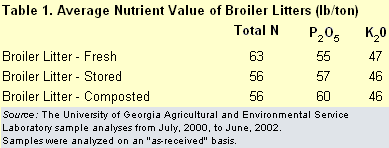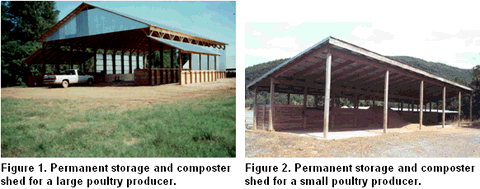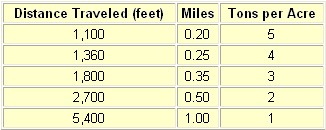



Best Management Practices for Storing and Applying Poultry Litter
By Dan L. Cunningham, Casey W. Ritz and William C. Merka1, Extension Poultry Scientists at the University of Georgia - This report looks at the Primary Nutrients of Concern and the best methods for storing and applying poultry litter.Georgia poultry farmers produce more than 2.0 million tons of poultry litter/manure annually in the process of producing meat and eggs. Fortunately, when stored and applied appropriately, this material has value as an organic fertilizer and soil conditioner. As a result, poultry litter/manure has been applied to Georgia's soils dating back to the beginning of the poultry industry in Georgia. The nutrients and organic materials found in poultry litter/manure are extremely beneficial by-products, as evidenced by the fact that years of application have transformed north Georgia from a severely depleted landscape in the 1920s and 1930s to a productive and green one today. Over-application or improper storage of poultry litter, however, can cause nutrient contamination of the state's waters. Given the size and economic importance of this key agricultural industry, poultry producers must properly use this material to obtain maximum economic value of its fertilizer qualities while assuring protection of the environment.
Primary Nutrients of Concern
The primary nutrients of concern in poultry litter are nitrogen and phosphorous. Both nutrients have value as a plant food, but they also can cause contamination of surface and ground waters with excessive application.
Nitrogen
Most of the nitrogen found in poultry manure or litter is in the form of organic nitrogen. A smaller amount of the nitrogen in the litter is ammonium. Organic nitrogen can be converted to inorganic nitrogen by bacteria in the soil. Plants can then use inorganic nitrogen for growth. Excessive organic and ammonium forms of nitrogen can be transformed into nitrate nitrogen, which in high levels in drinking water can harm human health. Excess nitrogen may be removed from application sites by surface runoff from rain storms and by leaching. This nitrogen can end up in surface or ground water, causing nutrient contamination.
Phosphorous
Poultry manure contains phosphorous as a result of natural excretions and from the phosphorous added as an ingredient in poultry feeds. Certain forms of the phosphorous used in poultry feeds are poorly absorbed by the chicken's digestive tract, and this unabsorbed phosphorous is eliminated in the manure. Years of poultry manure applications have resulted in some phosphorous laden soils in Georgia. Soils with excessive phosphorous levels, if not managed properly, can be a source of soluble phosphorous contamination via runoff into surface waters. Excessive soluble phosphorous in water can cause excessive plant and algal growth that can lead to fish kills as a result of depleted oxygen levels in the water.
Adherence to "Best Management Practices" can reduce or eliminate the potential for these nutrients to become environmental issues for poultry farmers. Using appropriate methods for storage and application of poultry litter will assure maximum fertilizer values and environmental protection for your farm and community.
Storing Poultry Litter
Why Storage Is Necessary
The cleaning of a poultry house depends on the schedule of flocks and will vary considerably from company to company. These schedules do not always coincide with crop production periods or proper soil conditions that would allow spreading of poultry litter. Many poultry producers, therefore, are required to hold the litter in temporary storage until appropriate application times. Storing poultry litter properly will assure the most beneficial use of the valuable fertilizer nutrients and prevent water contamination on poultry farms.
The maximum value of poultry litter as a fertilizer occurs at the time of its removal from the poultry house. This is the point at which the nitrogen content is greatest (see Table 1). The longer poultry litter is held prior to its application to soils, the more available nitrogen is lost to the atmosphere in the form of ammonium. Stockpiling uncovered manure during the winter season can cause reductions in nitrogen content. In addition, uncovered litter piles can result in runoff from storm water and can be considered a point source pollution problem. Storing poultry litter properly, however, can reduce the amount of nitrogen lost to the atmosphere and protect your farm's environment. Never leave poultry manure uncovered and exposed to rain.

Methods for Storing Poultry Litter
Covered Stockpiles
Stockpiles of litter can be protected from rain and erosion by covering them with plastic sheeting anchored with earth and/or other devices such as auto tires. This method represents the least expensive way for storing litter, but it may not be the most effective way for protecting the environment. For this reason, it is recommended only as a temporary storage method. When using this method, choose a high, well drained location away from drainage ditches. Use berms or ditches, if necessary, to prevent surface water from running into or through the stockpile. Anchor the edges by laying the sheeting across a small trench approximately 12 inches deep and back-filling with soil. Lay used tires or other anchoring devices over the top of the plastic. Improperly anchored plastic will become loosened in the wind and may tear or blow off the pile. Heavy gauge (6 mil) plastic sheeting works best and can last one or two seasons. Lighter gauge material is not recommended.
Stockpiles with Ground Liners
Where stockpiles must be located on high water table soils, use a ground liner to prevent leaching. A liner must be accompanied by a cover. A liner can be as simple as a sheet of 6 mil plastic laid on the soil surface on top of which the stockpile is formed, or it can be as elaborate as a concrete slab that can be covered with plastic or a permanent cover. The value of ground liners is that they prevent nutrients from leaching into ground water. Most leaching occurs when a large part of the pile has been used but a small amount is left and the cover is removed. Get as much of the litter as possible removed from the site to prevent leaching.
Permanent Storage Structures
For larger poultry operations, permanent storage structures may be the most practical method for storing litter. Permanent structures should have concrete floors and be covered so the litter is protected from rain. The roof should be clear span supported by outside walls or perimeter posts. Interior posts will obstruct loading and unloading and might be a source of fire if spontaneous combustion conditions of the manure are just right. Roof heights must be sufficient to allow manure piling and equipment operation. Roofs of 12 feet or more may require wall panels to protect the stored litter from blowing rain. The Natural Resource Conservation Service (NRCS), and the Department of Biological and Agricultural Engineering at the University of Georgia have plans available for stack houses and compost facilities. These structures are well designed and are required by NRCS for cost sharing programs. Most poultry producers, however, can use less expensive and functional storage facilities. What's important is that a storage facility is functional and protects the litter material from rain and ground water.

Take care to operate litter storage and compost sheds in a manner that will prevent fires. Improperly stockpiled litter can generate enough heat to cause the wood in the storage structure to burn. The following steps will help prevent over-heating of stored litter.
Stored litter should not exceed 7 feet in depth at the center of the pile.
- Keep different age litter stored separately.
- Prevent storm water intrusion.
Monitor the internal temperature of the pile. Litter with temperatures that exceed 180 degrees F must be moved to prevent spontaneous combustion.
Improved storage methods for poultry litter are necessary to allow the most effective use of the nutrients contained in the manure. Poultry litter storage can be done in a variety of ways with a great range of investment costs and management programs. The use of poultry litter storage structures is considered a Best Management Practice for protecting the environment and maximizing the fertilizer value of this material. Litter storage structures will become more important and more prevalent as the poultry industry continues to implement environmentally sound management programs. Your local Cooperative Extension Service or your Natural Resource Conservation Service office can provide assistance in planning for proper litter storage.
Methods for Applying Poultry Litter
Nutrient Management Plans (NMPs)
Proper application of poultry litter requires a nutrient management plan. A nutrient management plan is essentially a collection of best management practices that assures the appropriate use of animal manures and commercial fertilizers to provide crop nutrient requirements while simultaneously protecting surface and ground waters from over-application. In addition, crop production cost can be significantly reduced by effective use of this poultry farm product. Poultry litter has a calculated value of $25 to $50 per ton as a replacement for commercial fertilizers, depending on the individual farm circumstances and the equi-valent cost for commercial fertilizer nutrients. To effectively and responsibly use poultry litter, certain poultry producers are required by the Georgia Environmental Protection Division (GEPD) to implement NMPs. Regardless of state-mandated programs covering some poultry producers, all poultry producers are strongly encouraged to develop a nutrient management plan (NMP) for protecting their farm's environment and from potential neighbor complaints.
Components of an NMP
A properly constructed and implemented NMP requires the completion of several key components. These components are:
Farm Mapping. Identify the fields and tracts of land on which poultry litter will be applied. Locate surface waters and wells on the property with appropriate setback distances for application. Do not apply poultry manure within 100 feet of surface waters or wells unless a 35-foot vegetative buffer can be provided.
Soil and Litter Analysis. Laboratory analysis of soil and poultry litter nutrient levels are necessary for determining the appropriate application rates. Soil samples can be taken on a 2 to 3 year cycle. Litter analysis should be done on an annual basis. Contact your local Cooperative Extension Service Office for assistance.
Nutrient Budgets. Determine the appropriate amount of poultry litter to be applied based on the soil and litter analysis, the amount of commercial fertilizer used, and the crop nutrient requirements. The use of a phosphorous risk index (P-Index) can be incorporated into the NMP to determine if litter/manure application is most appropriately done on a nitrogen or phosphorous basis.
Record Keeping. Document the annual manure production on the farm, the amount applied to the land, and the amount transported off the farm. Documentation is critical to demonstrating the appropriate use of poultry manure on the farm.
Proper Handling and Storage. Document storage procedures when utilized and calibrate manure spreading equipment.
Mortality Disposal. Document appropriate dead bird disposal procedures using state Department of Agriculture approved methods and emergency action plans when needed.
Detailed information on developing and implementing NMPs can be obtained from the Department of Poultry Science and the Department of Biological and Agricultural Engineering at the University of Georgia, or from the local Cooperative Extension Service Office.
Other Considerations in Application
The importance of selecting an appropriate site for manure applications cannot be overemphasized. Consideration of potential effects on the environment and neighbor relations when applying poultry manure can be very important to the success of any manure utilization program. Attention to details prior to spreading can potentially reduce problems in these areas and minimize adverse public relations. Some suggested practices for site selection are:
Do not apply poultry litter to land that is too steep. Ideally, slopes of land should not be more than 10 to 15 percent.
Use sites as far away from surface waters as possible. When spreading in close proximity to surface waters, drainage ditches or wetlands, use either a 100-foot setback or a 35-foot vegetative buffer. Applications from wells must be maintained at a minimum of 100 feet.
Use the P-Index to determine if your farm represents a high risk site for phosphorous runoff. For farms representing a high risk situation, use management practices that reduce this risk.
Use sites that are as isolated as possible. The farther away from neighbors and public facilities the better. Out of sight often means out of mind.
Pay attention to weather forecasts before spreading. Avoid spreading prior to heavy rains. Be aware of prevailing wind conditions and avoid spreading when it might have an impact on neighbors. Apply poultry litter when crops can best use the nutrients.
- A spreader bed that holds 20 cubic feet of litter per foot of bed length.
- Litter weighs approximately 30 pounds per cubic foot.
- The swath width of the spreader is 40 feet.
- The spreader has a 16 foot long bed and will hold 9,600 pounds (20 cubic feet per foot of bed x 30 pounds/cubic foot x 16 feet of bed = 9,600 pounds).
- With a swath width of 40 feet, the spreader truck will cover 1 acre for each 1,100 feet traveled ( 40 feet x 1,100 feet = 44,000 square feet).
To determine the application rate, use the odometer to measure the distance traveled to put out one load. In this example, 5 tons per acre were applied when the truck put out one load as it traveled 1,100 feet. The following table demonstrates the different rates of application with different distances traveled to put out one load of litter.

Swath widths, different than the more common 40 feet used here, would require recalculation of the application rates for the distances traveled.
Summary
Adhering to Best Management Practices for storing and applying poultry litter will result in obtaining the maximum fertilizer value of this valuable animal by-product while assuring protection of the state's surface and ground waters. Nutrient Management Plans are essential for the appropriate application of important crop nutrients, but responsible management includes more than just applying the correct amount of poultry litter.
Responsible management also requires consideration of appropriate sites, timing of application and consideration of neighbors. Maintaining and calibrating spreader equipment on a regular basis will ensure that the calculated rates of application from the NMP are actually delivered as intended. It is important for all growers to practice Best Management programs for the utilization of their poultry litter. It takes only one poorly managed poultry operation to negatively impact all producers in a community.
Source: University of Georgia - Poultry Science - July 2003









